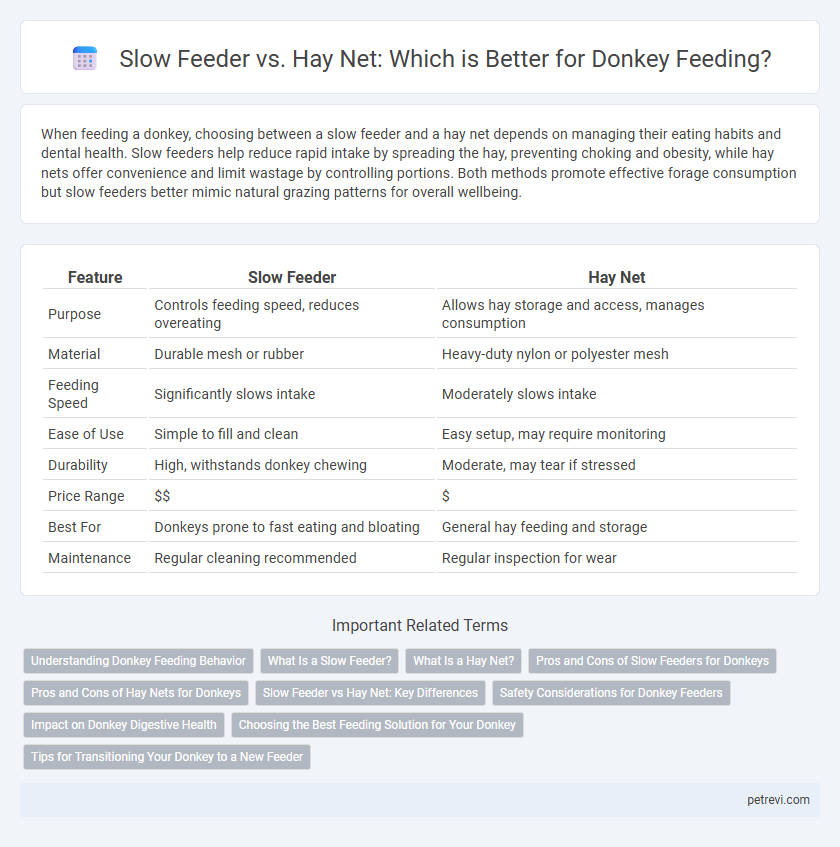When feeding a donkey, choosing between a slow feeder and a hay net depends on managing their eating habits and dental health. Slow feeders help reduce rapid intake by spreading the hay, preventing choking and obesity, while hay nets offer convenience and limit wastage by controlling portions. Both methods promote effective forage consumption but slow feeders better mimic natural grazing patterns for overall wellbeing.
Table of Comparison
| Feature | Slow Feeder | Hay Net |
|---|---|---|
| Purpose | Controls feeding speed, reduces overeating | Allows hay storage and access, manages consumption |
| Material | Durable mesh or rubber | Heavy-duty nylon or polyester mesh |
| Feeding Speed | Significantly slows intake | Moderately slows intake |
| Ease of Use | Simple to fill and clean | Easy setup, may require monitoring |
| Durability | High, withstands donkey chewing | Moderate, may tear if stressed |
| Price Range | $$ | $ |
| Best For | Donkeys prone to fast eating and bloating | General hay feeding and storage |
| Maintenance | Regular cleaning recommended | Regular inspection for wear |
Understanding Donkey Feeding Behavior
Donkeys have a natural grazing behavior that involves slow, continuous feeding, which slow feeders effectively replicate by extending feeding time and reducing boredom. Hay nets allow easy access but can lead to rapid consumption, increasing the risk of digestive issues common in donkeys such as colic and obesity. Opting for slow feeders aligns better with donkeys' need for prolonged foraging, supporting healthier digestion and mental well-being.
What Is a Slow Feeder?
A slow feeder is a specially designed feeding device that controls a donkey's access to hay, promoting slower eating and reducing the risk of digestive issues. Made from durable materials with small openings, slow feeders mimic natural grazing behaviors by encouraging longer feeding times. This method helps prevent boredom, minimizes food waste, and supports better dental and gut health in donkeys.
What Is a Hay Net?
A hay net is a durable mesh bag designed to hold hay, regulating a donkey's feeding speed by limiting the amount of hay accessible at one time. It helps prevent overeating and reduces waste by mimicking natural grazing behavior, promoting slower, healthier consumption. Available in various hole sizes, hay nets provide controlled intake that supports dental health and prevents boredom.
Pros and Cons of Slow Feeders for Donkeys
Slow feeders for donkeys promote natural grazing behavior by extending feeding time, reducing boredom, and preventing rapid ingestion that can cause digestive issues. They are typically more durable and safer than hay nets, minimizing the risk of entanglement and injury. However, slow feeders can be more expensive and less portable, requiring regular cleaning to prevent mold and maintain hygiene.
Pros and Cons of Hay Nets for Donkeys
Hay nets for donkeys provide controlled feeding by slowing down hay consumption, reducing the risk of choking and promoting digestion. However, they can cause wear on donkeys' teeth if the mesh size is too small and may lead to frustration or injury if donkeys struggle to extract hay. Proper net selection and regular monitoring are essential to balance feeding benefits and animal welfare.
Slow Feeder vs Hay Net: Key Differences
Slow feeders are designed to regulate a donkey's eating pace by restricting access to hay, promoting natural foraging behavior and preventing overeating, while hay nets primarily serve as a storage solution that hangs hay at an accessible height but may not significantly slow consumption. Slow feeders often feature smaller openings or dense mesh, providing controlled intake and reducing waste, whereas hay nets vary in mesh size and can sometimes allow rapid hay pulling, leading to faster consumption. Selecting between a slow feeder and a hay net depends on managing feeding speed, preventing obesity, and minimizing hay wastage for optimal donkey health.
Safety Considerations for Donkey Feeders
Slow feeders and hay nets both promote slower eating in donkeys, but safety considerations differ significantly. Slow feeders, designed with durable, chew-resistant materials and minimal large gaps, reduce the risk of dental injury and limb entrapment common with poorly maintained or loosely woven hay nets. Choosing feeders specifically labeled as safe for equines and regularly inspecting for wear or damage ensures donkeys feed safely and reduces the risk of choking, stress, or accidental injury.
Impact on Donkey Digestive Health
Slow feeders regulate the intake of forage, promoting natural grazing behavior and reducing the risk of colic and obesity in donkeys. Hay nets, while convenient, can cause rapid consumption, leading to digestive disturbances such as choke or colic due to inconsistent feeding rates. Prioritizing slow feeders over hay nets supports optimal digestive health by maintaining steady saliva production and gut motility essential for donkey wellbeing.
Choosing the Best Feeding Solution for Your Donkey
Choosing the best feeding solution for your donkey involves comparing Slow Feeders and Hay Nets based on feeding pace, safety, and enrichment. Slow Feeders regulate intake by limiting access to hay, reducing overeating and promoting natural foraging behavior, while Hay Nets offer convenience but may encourage faster consumption and potential dental issues. Prioritize Slow Feeders for controlled, healthy feeding habits and Hay Nets for easy transport and storage, ensuring your donkey's dietary needs and well-being are met effectively.
Tips for Transitioning Your Donkey to a New Feeder
When transitioning your donkey to a new feeder, introduce the slow feeder or hay net gradually by mixing the old feeding method with the new one over several days to prevent digestive upset. Ensure the slow feeder or hay net is securely fastened at donkey-friendly heights to encourage natural grazing behavior and reduce stress. Monitor your donkey closely for any changes in eating patterns or signs of discomfort to adjust feeding strategies promptly.
Slow Feeder vs Hay Net for Donkey Feeding Infographic

 petrevi.com
petrevi.com